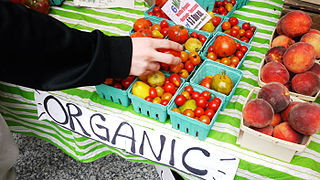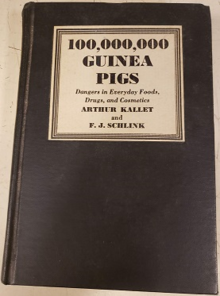
The United States Food and Drug Administration is a federal agency of the Department of Health and Human Services. The FDA is responsible for protecting and promoting public health through the control and supervision of food safety, tobacco products, caffeine products, dietary supplements, prescription and over-the-counter pharmaceutical drugs (medications), vaccines, biopharmaceuticals, blood transfusions, medical devices, electromagnetic radiation emitting devices (ERED), cosmetics, animal foods & feed and veterinary products.

The Pure Food and Drug Act of 1906, also known as the Wiley Act and Dr. Wiley's Law, was the first of a series of significant consumer protection laws enacted by the United States Congress, and led to the creation of the Food and Drug Administration (FDA). Its main purpose was to ban foreign and interstate traffic in adulterated or mislabeled food and drug products, and it directed the US Bureau of Chemistry to inspect products and refer offenders to prosecutors. It required that active ingredients be placed on the label of a drug's packaging and that drugs could not fall below purity levels established by the United States Pharmacopeia or the National Formulary.

The organic movement broadly refers to the organizations and individuals involved worldwide in the promotion of organic food and other organic products. It started during the first half of the 20th century, when modern large-scale agricultural practices began to appear.
Consumers' Research is a 501(c)(3) non-profit organization established in 1929 by Stuart Chase and F. J. Schlink after the success of their book Your Money's Worth galvanized interest in testing products on behalf of consumers. It published a monthly magazine called Consumers' Research Bulletin. Leading staff from this organization, thwarted in their efforts to establish a collective bargaining unit of a labor union, protested and left to form Consumers Union in 1936. The magazine published by Consumers Union, initially Consumers Union Reports and now called Consumer Reports, gained popularity and market share over the Bulletin and largely supplanted its relevance.
Arthur Kallet was an American consumer advocate.

The United States Federal Food, Drug, and Cosmetic Act is a set of laws passed by the United States Congress in 1938 giving authority to the U.S. Food and Drug Administration (FDA) to oversee the safety of food, drugs, medical devices, and cosmetics. The FDA's principal representative with members of congress during its drafting was Charles W. Crawford. A principal author of this law was Royal S. Copeland, a three-term U.S. senator from New York. In 1968, the Electronic Product Radiation Control provisions were added to the FD&C. Also in that year the FDA formed the Drug Efficacy Study Implementation (DESI) to incorporate into FD&C regulations the recommendations from a National Academy of Sciences investigation of effectiveness of previously marketed drugs. The act has been amended many times, most recently to add requirements about bioterrorism preparations.

The Toxic Substances Control Act (TSCA) is a United States law, passed by the 94th United States Congress in 1976 and administered by the United States Environmental Protection Agency (EPA), that regulates chemicals not regulated by other U.S. federal statutes, including chemicals already in commerce and the introduction of new chemicals. When the TSCA was put into place, all existing chemicals were considered to be safe for use and subsequently grandfathered in. Its three main objectives are to assess and regulate new commercial chemicals before they enter the market, to regulate chemicals already existing in 1976 that posed an "unreasonable risk of injury to health or the environment", as for example PCBs, lead, mercury and radon, and to regulate these chemicals' distribution and use.

The Federal Insecticide, Fungicide, and Rodenticide Act (FIFRA) is a United States federal law that set up the basic U.S. system of pesticide regulation to protect applicators, consumers, and the environment. It is administered and regulated by the United States Environmental Protection Agency (EPA) and the appropriate environmental agencies of the respective states. FIFRA has undergone several important amendments since its inception. A significant revision in 1972 by the Federal Environmental Pesticide Control Act (FEPCA) and several others have expanded EPA's present authority to oversee the sales and use of pesticides with emphasis on the preservation of human health and protection of the environment by "(1) strengthening the registration process by shifting the burden of proof to the chemical manufacturer, (2) enforcing compliance against banned and unregistered products, and (3) promulgating the regulatory framework missing from the original law".

Lotion is a low-viscosity topical preparation intended for application to the skin. By contrast, creams and gels have higher viscosity, typically due to lower water content. Lotions are applied to external skin with bare hands, a brush, a clean cloth, or cotton wool.
Title 21 is the portion of the Code of Federal Regulations that governs food and drugs within the United States for the Food and Drug Administration (FDA), the Drug Enforcement Administration (DEA), and the Office of National Drug Control Policy (ONDCP).

Cosmetics ingredients come from a variety of sources but, unlike the ingredients of food, are often not considered by most consumers. Cosmetics often use vibrant colors that are derived from a wide variety of sources, ranging from crushed insects to rust.
Frederick J. Schlink was an American consumer rights activist. He co-wrote the book 100,000,000 Guinea Pigs with Arthur Kallet, and co-founded the watchdog group Consumers' Research.

Cosmetic testing on animals is a type of animal testing used to test the safety and hypoallergenic properties of cosmetic products for use by humans.

The regulation of food and dietary supplements by the U.S. Food and Drug Administration is a process governed by various statutes enacted by the United States Congress and interpreted by the U.S. Food and Drug Administration ("FDA"). Pursuant to the Federal Food, Drug, and Cosmetic Act and accompanying legislation, the FDA has authority to oversee the quality of substances sold as food in the United States, and to monitor claims made in the labeling about both the composition and the health benefits of foods.
The history of early food regulation in the United States started with the 1906 Pure Food and Drug Act, when the United States federal government began to intervene in the food and drug businesses. When that bill proved ineffective, the administration of President Franklin D. Roosevelt revised it into the Federal Food, Drug and Cosmetic Act of 1937. This has set the stage for further government intervention in the food, drug and agricultural markets.
The consumer movement is an effort to promote consumer protection through an organized social movement, which is in many places led by consumer organizations. It advocates for the rights of consumers, especially when those rights are actively breached by the actions of corporations, governments, and other organizations that provide products and services to consumers. Consumer movements also commonly advocate for increased health and safety standards, honest information about products in advertising, and consumer representation in political bodies.
Consumer Health Laws are laws that ensure that health products are safe and effective and that health professionals are competent; that government agencies enforce the laws and keep the public informed; professional, voluntary, and business organizations that serve as consumer advocates, monitor government agencies that issue safety regulations, and provide trustworthy information about health products and services; education of the consumer to permit freedom of choice based on an understanding of scientific data rather than misleading information; action by individuals to register complaints when they have been deceived, misled, overcharged, or victimized by frauds.
Mary Catherine Phillips (1903–1981) was an American consumer advocate, author, and member of the Board of Directors of Consumers' Research in Bowerstown, New Jersey. She tested consumer beauty products, promoted safety for cosmetics, and wrote Skin Deep. The Truth About Beauty Aids – Safe and Harmful.

Ruth deForest Lamb was the first Chief Educational Officer at the U.S. Food and Drug Administration (FDA) and the author of American chamber of horrors: the truth about food and drugs (1936). She organized consumer support for the passage of the Federal Food, Drug, and Cosmetic Act of 1938, particularly targeting congressional wives and women's groups.

Beatrice Josephine Trum Hunter was an American natural foods campaigner and writer.









